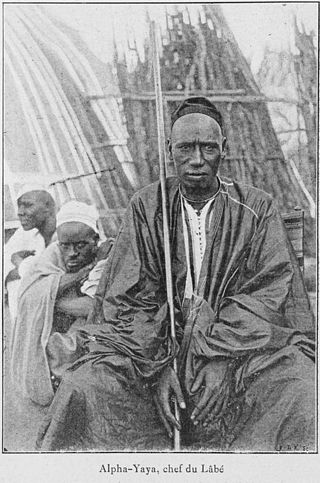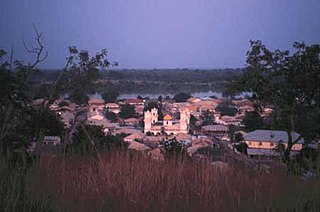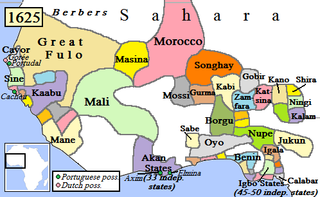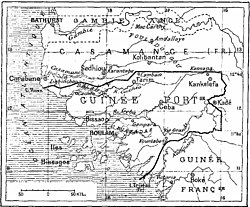
Guinea-Bissau, officially the Republic of Guinea-Bissau, is a country in West Africa that covers 36,125 square kilometres (13,948 sq mi) with an estimated population of 2,026,778. It borders Senegal to its north and Guinea to its southeast.
The region now known as Guinea-Bissau, in West Africa, has been inhabited by humans for thousands of years. During the 13th century CE, it was a province of the Mali Empire which later became independent as the empire of Kaabu. The Portuguese Empire claimed the region during the 1450s, but its control was limited to several forts along the coast during most of this period; it gained control of the mainland after a series of "pacification campaigns" from 1912 to 1915, which used military forces to violently crush local resistance. The offshore Bijagos Islands were not colonized until 1936. Guinea-Bissau gained independence from Portugal in 1974. The introduction of multi-party politics in 1991 led to the first multi-party elections in 1994. A civil war broke out in 1998, which lasted until the following year.

The Gambia River is a major river in West Africa, running 1,120 kilometres (700 mi) from the Fouta Djallon plateau in north Guinea westward through Senegal and The Gambia to the Atlantic Ocean at the city of Banjul. It is navigable for about half that length.

The Mandinka or Malinke are a West African ethnic group primarily found in southern Mali, The Gambia, southern Senegal and eastern Guinea. Numbering about 11 million, they are the largest subgroup of the Mandé peoples and one of the largest ethnolinguistic groups in Africa. They speak the Manding languages in the Mande language family, which are a lingua franca in much of West Africa. Virtually all of Mandinka people are adherent to Islam, mostly based on the Maliki jurisprudence. They are predominantly subsistence farmers and live in rural villages. Their largest urban center is Bamako, the capital of Mali.

Fouta Djallon is a highland region in the center of Guinea, roughly corresponding with Middle Guinea, in West Africa.
Articles related to Guinea-Bissau include:

Alfa Yaya Diallo Maudo, was a 19th-century ruler of Labé, one of the nine provinces of the Imamate of Futa Jallon, in present-day Guinea.

Bansang is a town in the Central River Division of the Gambia, with a population of 8,843 (2012). Although the official government center of the Division is located in Janjanbureh downstream, Bansang has better access to the more affluent coastal region of the country, and is sometimes considered the unofficial "upcountry" economic capital.

Kaabu (1537–1867), also written Gabu, Ngabou, and N'Gabu, was a federation of Mandinka kingdoms in the Senegambia region centered within modern northeastern Guinea-Bissau, large parts of today's Gambia, and extending into Koussanar, Koumpentoum, and the Casamance in Senegal.
Daniel Laemouahuma Jatta is a Jola scholar and musician from Mandinary, Gambia, who pioneered the research and documentation of the akonting, a Jola folk lute, as well as the related Manjago folk lute, the buchundu, in the mid-1980s. Prior to Jatta's work, these instruments were largely unknown outside the rural villages of the Senegambia region of West Africa.

The Imamate of Futa Jallon or Jalon, sometimes referred to as the Emirate of Timbo, was a West African Islamic state based in the Fouta Djallon highlands of modern Guinea. The state was founded in 1725 by a Fulani jihad and became part of French West Africa in 1896.
The Bainuk people are an ethnic group that today lives primarily in Senegal as well as in parts of Gambia and Guinea-Bissau.
The kingdom of Kasa, also known as Kasanga, was the dominant kingdom in lower Casamance during the 15th and 16th centuries. Many of the inhabitants of the realm were Bainuk or other native ethnicities, but it was ruled by a Mandinkized elite. The capital was at Brikama, on the south bank of the Casamance River.
The Battle of Kansala or Turban Keloo was the siege of the capital of the Kaabu federation in 1867 by the Imamate of Futa Jallon, allied with rebellious Fula people from Kaabu itself. The battle, which saw the town completely destroyed, ended Mandinka hegemony over Africa’s Atlantic coast begun by the Mali Empire.

Ziguinchor is the capital of the Ziguinchor Region, and the chief town of the Casamance area of Senegal, lying at the mouth of the Casamance River. It has a population of 214,874. It is the eighth largest city of Senegal, but is nearly separated from the north of the country by the nation of The Gambia.
Mussa Moloh, also written as Musa or Moussa Molo was the last king of Fuladu in the Senegambia region. A ruthless and powerful ruler, he played different colonial powers off of each other for decades before being defeated by the French in 1903 and exiled to The Gambia. Musa Molo was the last precolonial leader to exert real territorial control in the region.
Fodé Kaba Doumbouya, also spelled Dumbuya, was a Diakhanke marabout in the 19th century, one of the leaders resisting French and British colonial expandion in Senegambia.
Alfa Yaya Molo Balde was the founder of Fuladu, a kingdom in the Casamance region of modern-day Senegal.
The Soninke-Marabout Wars were a series of 19th-century civil wars across southern Senegambia pitting the traditional ruling classes of various states, mostly animist or only nominally Muslim, against Islamic reformers led by the marabout class. French and British forces frequently became involved in these conflicts, providing them an opportunity to extend colonial power into the hinterland.

The Battle of Fancá (1886) was a military engagement that took place in Fancá, modern-day Gabú, Guinea-Bissau, between Portuguese colonial forces, commanded by Marques Geraldes, supported by local allies under Nbuku, and the forces of Fuladu, led by Musa Molo.










